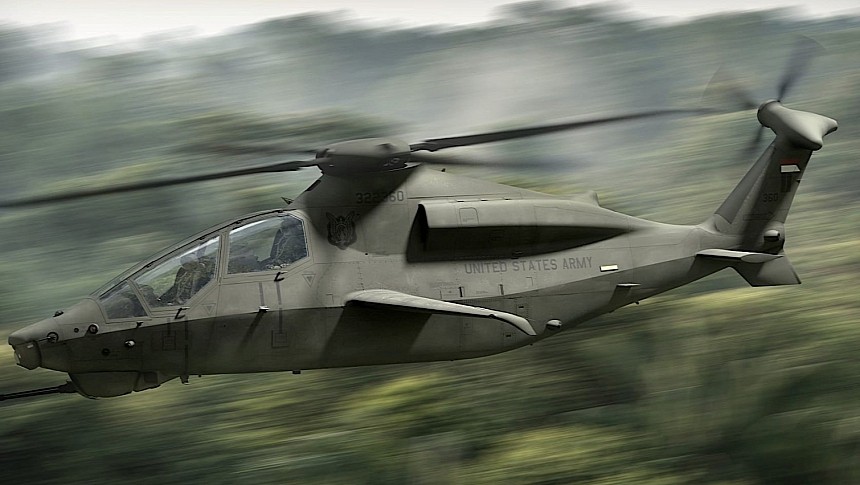The U.S. Army is on the lookout for a new attack helicopter. It wants one as it plans to replace the aging Bell OH-58 Kiowa with something more modern and more capable. To do that, it kicked off back in 2018 the Future Attack Reconnaissance Aircraft (FARA) program.
FARA is currently in its closing stages, with just two helicopter designs left to compete for the win. One is the Sikorsky Raider, and the second the Bell 360 Invictus. It's the latter that made the headlines this week, as it reached a major milestone in its development.
You see, both helicopters will be powered by the same General Electric (GE) turboshaft engine, selected by the Army specifically for this purpose. It's in fact the same powerplant that is being fitted in the UH-60 Black Hawk and AH-64 Apache.
The engine is called T901, a unit that is supposed to be 50 percent more powerful than the T700 currently being deployed in Black Hawks and Apaches. Depending on variant, the T700 was capable of developing anywhere between 1,768 and 1,915 shaft horsepower.
In the FARA helicopters the power output is said to sit at 3,000 shaft horsepower, making both of them monsters not to be messed with. The engine will also need a lot less fuel to operate – consumption levels should drop by as much as 25 percent compared to the T700.
It was this week when Bell announced it received from the U.S. Army the T901 engine that will go into the Invictus. The company will now install it into the helicopter, and proceed with ground test operations.
The GE engine will not be the only one supplying power to the Invictus. It will be backed by a smaller Pratt & Whitney unit for extra power. With the blades up top spinning at their fastest, the Invictus should be capable of reaching speeds of 210 mph (330 kph).
As per the requirements of the FARA program, there are few mechanical restrictions to what Bell engineers can do. The main requirement of the Army, aside from the helos using the T901 engine, was for the rotor diameter and fuselage width not to exceed 40 feet (12 meters).
It will of course have to be able to carry the full complement of airborne weapons in the Army's arsenal, as the winner of the FARA program is meant to be something the Army calls a knife fighter.
Bell does not say how long it will take before the Invictus takes to the sky for the first time. The American military plans to pick the winning design and send it into production in 2028. At least that was the initial goal, as FARA already seems to be running behind schedule – test flight evaluations should have already been performed this year.
You see, both helicopters will be powered by the same General Electric (GE) turboshaft engine, selected by the Army specifically for this purpose. It's in fact the same powerplant that is being fitted in the UH-60 Black Hawk and AH-64 Apache.
The engine is called T901, a unit that is supposed to be 50 percent more powerful than the T700 currently being deployed in Black Hawks and Apaches. Depending on variant, the T700 was capable of developing anywhere between 1,768 and 1,915 shaft horsepower.
In the FARA helicopters the power output is said to sit at 3,000 shaft horsepower, making both of them monsters not to be messed with. The engine will also need a lot less fuel to operate – consumption levels should drop by as much as 25 percent compared to the T700.
It was this week when Bell announced it received from the U.S. Army the T901 engine that will go into the Invictus. The company will now install it into the helicopter, and proceed with ground test operations.
The GE engine will not be the only one supplying power to the Invictus. It will be backed by a smaller Pratt & Whitney unit for extra power. With the blades up top spinning at their fastest, the Invictus should be capable of reaching speeds of 210 mph (330 kph).
As per the requirements of the FARA program, there are few mechanical restrictions to what Bell engineers can do. The main requirement of the Army, aside from the helos using the T901 engine, was for the rotor diameter and fuselage width not to exceed 40 feet (12 meters).
It will of course have to be able to carry the full complement of airborne weapons in the Army's arsenal, as the winner of the FARA program is meant to be something the Army calls a knife fighter.
Bell does not say how long it will take before the Invictus takes to the sky for the first time. The American military plans to pick the winning design and send it into production in 2028. At least that was the initial goal, as FARA already seems to be running behind schedule – test flight evaluations should have already been performed this year.








